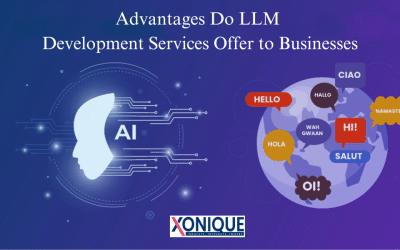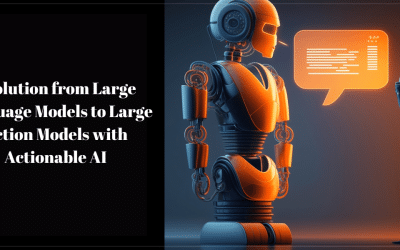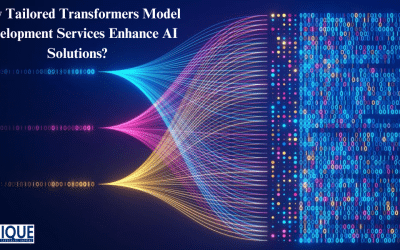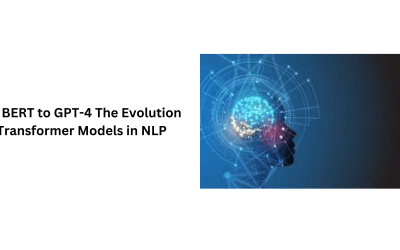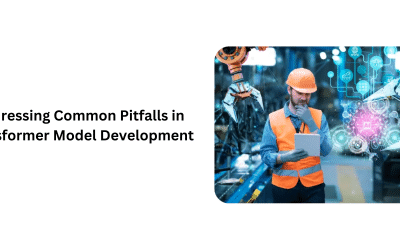LLMs have been trained to recognize patterns and structures to precisely comprehend context, semantics, and grammar. Using sophisticated algorithms and deep learning (DL) methods, they can create coherent paragraphs or complete essays indistinguishable from human-written texts.
The technological advances in LLMs have significantly impacted various domains in which human-machine interaction is essential. From improving search engine precision to enhancing the capabilities of virtual assistants, these advanced models have proven their potential to transform how we interact with technology.
However, the growth of LLMs has raised significant ethical questions about misinformation or fraudulent use of content generated by the system. For LLMs, finding an equilibrium between technological advancement and ethical AI usage is essential.
What are Large Language Models?
Large Language Models (LLMs) are artificial intelligence models designed to learn, generate, and exchange information with human languages. They are trained with deep learning methods, specifically neural networks, which use vast amounts of text data. Developing LLMs aims to comprehend human languages’ meaning, context, and syntax and perform tasks like translating, summarizing, answering questions, and creative writing.
LLMs are distinguished by their enormous size, typically consisting of millions of parameters. These parameters determine the weights and biases in the neural network that the model develops through training. The wide range of parameters allows LLMs to recognize intricate patterns and nuances within languages, allowing them to produce high-quality and contextually relevant texts.
Types of Large Language Models
Many kinds of large models of language have become popular in recent years, each having distinctive properties and uses. Here are a few of the most well-known varieties:
GPT (Generative Pre-trained Transformer):
GPT-3, developed by OpenAI, is among the most well-known examples. It has 175 billion variables and impressive capabilities in text generation, answering questions, language translation, and even code generation.
BERT (Bidirectional Encoder Representations of Transformers):
Google’s BERT models focus on understanding text bi-directionally, allowing them to collect context-specific information more efficiently. They excel at tasks like text classification and sentiment analysis.
T5 (Text-to-Text Transfer Transformer):
T5 models use a text-to-text framework in which every NLP activity is transformed into an established text-to-text format. This means that T5 is adaptable and flexible for various tasks requiring language.
XLNet:
XLNet Another model, XLNet from Google, was developed to recognize dependencies in text by analyzing every possible combination of words within a sentence. This helps the model understand the text’s context and its relationships.
Features of Large Language Model
Large-language models possess the capability to comprehend and produce text that is like human speech. To understand their importance and significance, let’s examine their unique characteristics and position them as essential components of modern-day language processing.
Natural Language Understanding
Large language models are based on two essential factors that help attain an exceptional understanding of natural language, one of their pillars.
Contextual Representation of Words: To comprehend words’ subtle concepts, a vast language model considers the context within which they appear. In contrast to traditional methods that separate terms, the models examine words by looking at their relationships with other words. This can lead to more precise interpretations and a better understanding of language.
Semantic Understanding: Models can comprehend the meaning behind paragraphs and sentences, allowing them to understand the fundamental concepts and extract pertinent information. This understanding allows for more sophisticated and appropriate contextual interactions.
Text Generation Capabilities
Large language models are highly adept at creating texts that are consistent and relevant to the context. This fantastic ability has resulted in the development of many applications.
- Literary Writing: These models are skilled in showing their artistic skills across various areas. They effortlessly express their creative flair by writing captivating stories, poetry that is captivating, and even melodic lyrics.
- Code Generation: The models have shown their ability to code by creating code snippets based on textual descriptions. This is a huge benefit for developers as it speeds up software development.
- Conversational Agents: Modern virtual and chatbots depend on a broad language model to form their basis. These advanced systems can engage in conversations that mimic human interactions, provide customer support, respond to inquiries, and assist users across different sectors.
Multilingual and Cross-Domain Competence
Language models with huge capacities can easily overcome language barriers and seamlessly adapt to various areas. This results in significant advances in multiple places, discussed in the following section.
- Breaking the Barriers of Language: The models transform how people communicate by enabling instant translation that ensures information is readily available to anyone worldwide in their home languages. This means they facilitate efficient collaboration and allow seamless communication across borders.
- Adapting to Different Domains: The models can quickly adapt to various topics. From medical records to legal papers, they can quickly create precise and relevant content, making them highly adaptable to multiple sectors. This flexibility dramatically enhances their usefulness and application.
Emerging Trends in LLMs
The field of large language models (LLMs) is growing and constantly pushing the limits with new developments. Let’s examine the latest trends emerging within the LLM space.
Small Language-Based Models: LLMs are accepted and embraced worldwide. SLMs are also receiving more interest and attention from LLM Development Companies focused on increasing effectiveness and safety. Furthermore, SLMs provide a sustainable, safe source of power that requires less power from computers and is suitable for use on-premise, a popular choice for businesses—models like Mistral-7B. Falcon 7B and others represent SLMs for their flexibility and effectiveness.
Thinking Functions: The latest abilities of LLM have been enhanced in logical reasoning, decreased errors, and investigated multi-model learning methods, which comprise audio, image videos, text, or even Code. Models such as GPT-5, LLAMA 3, and Gemini Ultra access the logical reasoning of LLM by integrating symbolic data and learning processes to make platforms and applications easily adaptable and usable for businesses.
Economy Revolution. The price of using or using LLM across various methods has slowed. For instance, in 2020, the cost of evaluating various product reviews using GPT-2 was about $10,000. Currently, GPT -4 provides similar results at about $3000. This has made LLMs more convenient, accessible, and cost-effective for businesses.
Finance and a Redesigned Developer Landscape: LLM developers will receive approximately $11.6 billion in funding by 2023. However, Open AI received around $13 billion in funding. In light of advancements and growth in LLM, this industry is witnessing an increase in the requirement for LLM developers with specific skills.
Benefits of Large Language Models
Large-scale language models provide various benefits, which contribute to improvements in the field of natural language processing as well as numerous applications. The following are the top advantages of large-scale language models:
Improvements in Language Generation: Large-scale language models comprehend and produce human-like texts with the highest consistency and contextual awareness levels. They recognize complex languages, their semantics, and context, providing more accurate and contextually appropriate outputs.
Effective Automation: Large Language Models automate tasks that generally require human involvement. They can handle customer inquiries or generate content, create summaries of documents, perform other language-related functions at a large scale, and reduce the requirement for human intervention. Automation improves efficiency, decreases operations costs, and increases productivity for companies and organizations.
Improved User Experience: Large language models are the basis for chatbots, conversational agents, and virtual assistants, significantly increasing the user experience. They facilitate more natural and engaging conversations by understanding the user’s intent and providing accurate and relevant responses. Utilizing LLMs to enable user interactions results in improved customer service, personalized recommendations, and efficient information retrieval.
Application Across Domains: Large-scale language models can be tuned to different tasks and domains. They can be trained using specific datasets or tuned for specific purposes, making them flexible and applicable to various applications and industries. This flexibility allows companies to utilize language models to suit their needs, including finance, healthcare, education, marketing, etc.
The advantages that large language models can provide have the potential to revolutionize industries, enhance communication, and create new possibilities for companies and individuals.
How To Implement Large Language Model In Your Process
Integrating a Large Language Model Development into your process can open up numerous possibilities. These sophisticated AI systems, also known as large-language models, can understand and create text that mimics human speech.
Their capabilities span various fields, making them indispensable instruments for productivity and improvement. In this article, we’ll give you step-by-step directions on seamlessly integrating an extensive language model into your workflow, leveraging its power to produce excellent results.
Determine Your Use Case
You must first understand the specific application to implement a large-scale language model successfully. This is crucial to understanding the needs and aids in choosing the suitable large language model while also adjusting parameters to achieve the best outcomes. The most common applications of LLMs include chatbots, machine translation, natural language inference, computational linguistics, and much more.
Choose the Right Model
Various big language models are readily available. The most popular models include GPT by OpenAI, BERT (Bidirectional Encoder Representations) by Google, and Transformer-Based models. Each large model has distinctive strengths and is suited to specific requirements. In contrast, Transformer models stand out in terms of their self-attention system, which proves helpful in understanding the context of texts.
Access the Model
After you have chosen the correct option, the next step is to connect it. Various LLMs are available as open-source alternatives on platforms such as GitHub. For instance, accessing OpenAI’s models may be accomplished through their API or downloading Google’s BERT model from their repository. If the desired language model isn’t open-source, contacting the service provider or getting authorization may be required.
Preprocess Your Data
One must first prepare the data to make the most of the large language model. This includes removing irrelevant details, resolving errors, and transforming the information into a format the language model can easily comprehend. These steps are essential because they significantly impact the model’s efficiency by shaping the input quality.
Fine-tune the Model
After your data has been completed, the massive refinement of the language model is ready to begin. This vital step will optimize the model’s parameters to suit the specific use case you have in mind. Although this procedure can take a long time, achieving optimal results is vital. It could require experimenting with different settings and retraining the model with varying datasets to find the best setting.
Implement the Model
After adjusting the model to your liking, you can incorporate it into your workflow. This may involve integrating the large language model in your application or creating it as a stand-alone service that you can access. Ensure it is compatible with the system and can take on the load.
Monitor and Update the Model
When the large model of language is in place, it becomes essential to keep track of its performance and make any necessary adjustments. The availability of new data could cause machine learning models to need to be updated. Therefore, frequent updates are vital to maintain high performance. In addition, adjustments to the parameters of your model could be necessary as your needs change.
Applications of Language Model in Artificial Intelligence
The language models provide a first step to general AI, which allows machines to process, understand, and create human-like languages and improve human-machine interaction. LLMs transform qualitative data into quantifiable data that computers and devices can understand. Here are a few examples of the model language in AI applications:
The models of language drive chatbots as well as voice bots that have conversations in natural language with users. Computers can comprehend and create human language and aid them in their queries that require information, such as sentiment analysis, translation of language, and many more.
Information retrieval: The algorithms improve search engines, assisting users to discover relevant information quicker and more efficiently by better understanding their queries.
Data analysis: The language models aid in extracting information from unstructured text data, allowing businesses to get helpful information from customer feedback on social media and reviews.
Customer engagement: in the field of customer services, models of language are the driving force behind automated responses that provide quick solutions, improving the customer experience and reducing time.
Customization Through Language Models: It allows businesses to tailor content, recommendations, and offerings to individual preferences, increasing satisfaction and conversion rates.
Language models that are part of artificial intelligence can be used in many industries due to their profound impact on communication, understanding, and automatization in the current digital age. Here are a few examples of the use of language models across different sectors:
Education: They help develop educational platforms by creating engaging content, quizzes, and explanations that make learning fun and effective.
Clinical Diagnostics: These help analyze medical literature and assist medical professionals in diagnosing and studying illnesses.
Language Preservation: These can help preserve and revive endangered languages by analyzing existing texts and creating content.
Legal Documentation: In the field of law, these models aid in the preparation of contracts, the study of law and case law, and the production of legal documents.
Marketing Research: Companies can analyze online conversations and discussions to determine public opinion and trends, which can help refine marketing strategies.
Changing the World of AI
Large-scale models of language are revolutionizing the realm of AI in a variety of significant ways:
The Human-Like Text Generating Model: They can create human-like text, which makes them helpful for creating content chatbots and virtual assistants. They are also used to develop chat programs, generate content, and write creative content.
Multilingual Communication: Large-scale models of languages could remove the language barrier. These models can precisely translate between languages, facilitating global communication and accessibility.
Analyzing and Insights into Data: These models can analyze and extract insights from unstructured text. They are used in trend detection, sentiment analysis, and opinion mining.
Semantic Search: Large language models have enhanced search engines’ ability to recognize user queries and provide better-quality results.
Accessibility: They’re being employed to create apps that allow content to people with disabilities, such as those with hearing or vision disabilities.
Personalization: Large models of language are generating recommendation systems, which help platforms such as Netflix and Amazon provide content based on user preferences.
Code Generation: Developers employ these models to generate Code that can dramatically improve software development speed.
Regulatory and Ethical Considerations
Large language models (LLMs) are a broad set of capabilities that allow seamless integration between businesses into efficient solutions. Yet, LLMs have a set of issues and limitations that you need to know about. Alongside the applications and trends, understanding the challenges is crucial to ensure that the various operational processes are run without errors. Before you put in the time and effort, consider an in-depth look at the challenges below.
Unfairness and Bias: LLMs tend to reflect biased results in training data, reducing the possibility of providing different outcomes. It is nevertheless essential to investigate functions like bias detection and mitigation strategies and ensure a fairness model based on languages to improve areas of research and development.
Security Measures: LLM can generate harmful or incorrect information. Therefore, designers must find ways to ensure safety and improve the security and robustness of these models against adversaries’ attacks.
Ethics Measures: Concerns are growing about the ethical implications of LLM, particularly for work involving creating content that contains false information, deeply fake situations, social consequences, and much more. These concerns must be identified, and solutions proposed to address them.
Resource Consumption: LLM frequently requires vast computing power to run and train the software. This has created a worry about reducing the use of the environmental footprint and keeping the model’s performance robust.
Transparency and the Ability to Explain Large Language Models need to interpret data, making it difficult to comprehend their decision-making method. This is why a growing need exists to improve the model’s explanation ability and transparency in various industries.
Data Confidentiality and Privacy: When data for training modeling languages is confidential, it’s crucial to implement robust data privacy measures to control the user’s data seamlessly.
Adoption Difficulties: In some instances, implementing LLM in real-time is difficult due to scalability, integration with other technology, and accessibility, which is one of the biggest problems of the present.
The Future of Large Language Models
LLMs have already had an impact on artificial intelligence. However, their possibilities are still ongoing, and research into new advancements continues.
Advancements in Large Language Models
One area of exploration for the future is the development of models with an even higher capacity for understanding and creating languages, like GPT models that have already shown remarkable capabilities. These models offer new opportunities for natural machine learning, enterprise chatbots, and AI virtual assistants that can seamlessly communicate with humans.
In contrast, with the most popular open-source models, such as ChatGPT, we’re seeing a rise in non-English-focused language models worldwide, like IndicBERT in India, which encompasses 12 essential Indian languages.
Another area for development is the use of large-language models for multilingual situations. Researchers are examining the development of models that effectively translate between languages, thus facilitating intercultural communication.
Increased Efficiency
As computational power grows, the speed and effectiveness of large-scale model languages are expected to increase dramatically. This improvement will lead to the creation of more intricate and precise models. Techniques like Retrieval-Augmented Generation (RAG) and fine-tuning will help make LLMs more cost-effective and efficient, allowing for a greater spread of implementation across diverse sectors.
Broader Integration
Large-scale language models are currently being used in a wide range of fields, including client service, the creation of new content, and language translation. However, their application is expected to become more widespread over the next few years as more businesses recognize the importance of AI-powered communication and data processing.
As LLMs become more integrated into different areas and fields, experienced professionals will need to design, implement, and manage the technology efficiently. This allows professionals with a technical background in language processing and artificial intelligence to develop their professional horizons further and contribute to advancing this exciting field.
Conclusion
Large Language Models (LLMs) are a revolutionary advancement in artificial intelligence. They have the potential to revolutionize the way people interact with technology. From facilitating more natural conversations to providing personalized recommendations for content, these models are at the forefront of technological innovation. While research and developments in the field continue to improve, we can anticipate excellent applications that enhance the integration of LLMs into our everyday lives, ushering in a new age of intelligent and responsive computing.
Artificial Intelligence (AI) has made incredible progress over the past few years, and one of its most significant accomplishments is the creation of massive models for language (LLMs). LLMs have transformed the world of natural language processing (NLP) by enabling machines to process and understand human-like texts at a huge size. They are highly sophisticated AI systems that are trained on huge text documents.
LLMs have been trained to recognize patterns and structures to comprehend context, semantics, and grammar with precision. Using sophisticated algorithms and deep learning (DL) methods, they can create coherent paragraphs or complete essays indistinguishable from human-written texts.
The technological advances made in LLMs have significantly impacted various domains in which human-machine interaction is essential. From improving search engine precision to improving the capabilities of virtual assistants, these advanced models have proven their potential to transform how we interact with technology.
However, the growth of LLMs has raised significant ethical questions about misinformation or fraudulent use of content generated by the system. For LLMs, finding an equilibrium between technological advancement and ethical AI usage is essential.
Frequently Asked Questions
What are Large Language Models (LLMs)?
LLMs are AI models trained on a huge amount of text. They understand language, context, and syntax and can translate, summarise, and more.
Can you name some popular types of Large Language Models?
GPT, BERT, T5, XLNet etc. Each has its features that help in understanding and generating language.
What are the capabilities of Large Language Models?
LLMs understand language. They can generate text, are multilingual, and have cross-domain competence.
How can I integrate Large Language Models into a process?
Implementing LLMs involves defining the use case, choosing the model, pre-processing data, fine-tuning, integration, and regular monitoring and updates.
Why should I consider using Large Language Models?
LLMs can generate language, automate better, improve user experience, and have applications across many domains.






